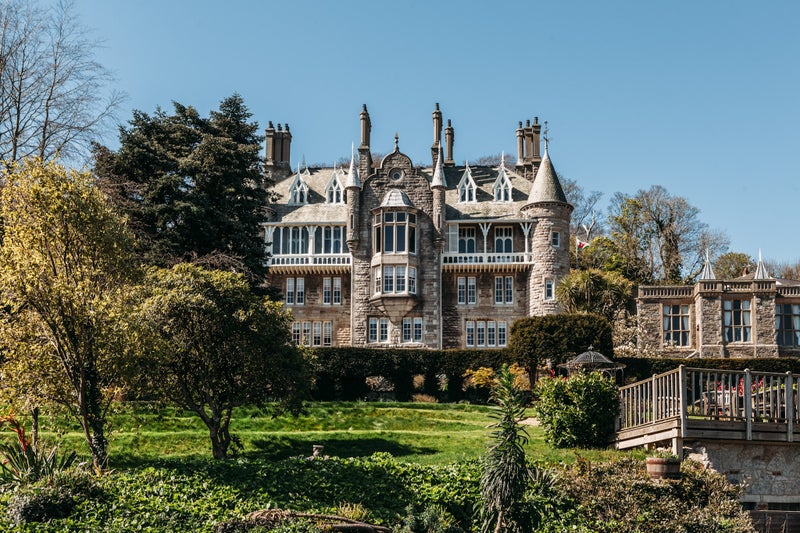In Melnik, Saint Trifon eclipses Saint Valentine as the town celebrates its long history of winemaking. The sun glows on the otherworldly shapes of the sandstone cliffs that have been sculpted by millennia of rain and left looking like someone tried to make sand castles but was too impatient to fill the bucket to the top. Jagged battlements and conical heaps stretch to the horizon. At the base of these cliffs stands a cluster of large, elegant houses. This is Melnik, Bulgaria’s smallest town, with just 194 residents. Despite its diminutive size, the town is famous as the heart of Bulgaria’s wine region. Every year, on 14 February, thousands of visitors arrive for Saint Trifon’s Day, a celebration of the patron saint of winemaking, which is a much bigger deal than Valentine’s Day, and dates back centuries.
![[Women in traditional dress lead a folk dance.]](https://i.guim.co.uk/img/media/6db416e6cd48bfabe980656f9de0d73bf1aac064/0_628_3905_2343/master/3905.jpg?width=445&dpr=1&s=none&crop=none)
The festivities begin when the wineries in the surrounding hills open their doors to visitors for tastings of the local red wine, but soon take on the atmosphere of a village fete when meat is thrown on the grill, and bagpipes, drums and fiddles strike up. Women in traditional dress lead a horo, a Bulgarian folk dance where the dancers link hands and move in winding lines. From here, the party moves on to the taverns in Melnik, which fill to the rafters, the noise growing proportionately to the number of jugs of house wine consumed – which is quite a few since they start at about £10 a litre. Soon, everyone is dancing again as an impromptu horo weaves between the tables and chairs.
![[Mavrud, a wine supposedly favored by Churchill, is available for tasting at the Melnik Wine Museum.]](https://i.guim.co.uk/img/media/82bbe2d5db362a76a558d88de5d1a3a97e60549c/0_0_4080_3072/master/4080.jpg?width=445&dpr=1&s=none&crop=none)
For most of the year, however, Melnik is a peaceful place. Two weeks before the festivities begin, I arrive for my fourth visit to the town and, as usual, I have barely stepped out of the car when I am called over by a man selling wine. “You have to try it. I made it,” he says, pouring me a glass of red from a two-litre plastic bottle. It is pleasantly sweet and easy to drink, but it makes navigating the cobblestones harder as I climb a sidestreet between old stone houses.
![[Ivan, a guide at Melnik's Wine Museum, places a label on a bottle.]](https://i.guim.co.uk/img/media/420e7ffa08e882b4aca26b1aa1f6d2d21885fabe/0_477_4080_2449/master/4080.jpg?width=445&dpr=1&s=none&crop=none)
Most of Melnik’s buildings date back to a time known as the National Revival, in the 18th and 19th centuries. Despite still being under Ottoman rule, Bulgarian writers and revolutionaries led a movement to promote patriotism, sparking a revival of local culture. Wealthy merchant families built their homes in a distinctive style, with overhanging upper floors, large windows and intricate decor. One of the best-preserved, Kordopulov House, is open to visitors. It looms over the road below, made to draw traders’ eyes. Following in their footsteps, I enter a large reception hall with stained glass windows. Next door is a chamber for private dealings, with a secret room hidden behind some bookshelves. The whole family could sit here to listen in on trade deals.
Many similar buildings now sit empty in the town. During the Ottoman era, Melnik was a major trading hub, and most of its population was Greek. In 1912 the town was incorporated into the newly founded Bulgaria, and a year later the Greek government ordered Melnik’s Hellenic community to relocate across the border, just 30km away. There is a disproportionate grandeur to these large empty houses, as though skyscrapers had been left behind in a village. They look out on to quiet streets, and the only merchants left are the ones selling wine and jam to tourists.
Back on the main street, I follow a sign to the Wine Museum, where information panels formatted as old scrolls and archive photos of winemakers line the walls. Wine has a long history here, dating back to the Thracians, who inhabited the region from about 1,000BC to the sixth century AD. According to the Roman scholar Pliny the Elder, the first European wine grower was a Thracian named Evmolp, and Thracian wines are mentioned in Homer’s epics.
The small exhibit serves as a cultural alibi for the museum’s tasting section, where large barrels await. The £4.50 entrance ticket includes five wine tastings, including a variety supposedly favoured by Winston Churchill, who was said to order two barrels each year. Locals love the tale, even if there’s no hard evidence. “Winston Leonard … What comes next?” asks the museum guide. “Erm … Henry?” I offer. “Spencer! Winston Leonard Spencer Churchill,” he says, handing me a glass of red mavrud, Churchill’s alleged favourite tipple. I see why he might have liked it. It has hints of tobacco, as though I was smoking a cigar while drinking.
But my favourite is a rosé made from a local grape called siroka melniska (broad-leaved melnik). It is light and fruity, and reminds me of fizzy fish sweets – apologies to wine connoisseurs. I ask for a bottle to take home. The guide fills it from the barrel, puts a cork in it, melts wax on top and hands it to me with a flourish. At dinner, sitting at a wooden table outside a mehana, or tavern, the smell of grilled meats fills the air, but I order a vegetable stew with slices of aubergine that melt in my mouth, alongside Bulgarian flatbread with paprika and cheese. Dessert is homemade ice-cream with caramelised nuts and candied figs.































